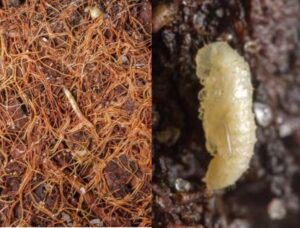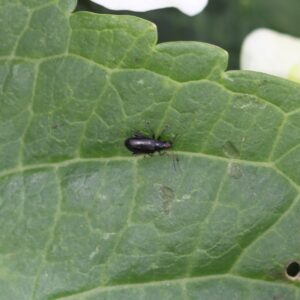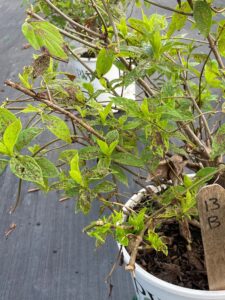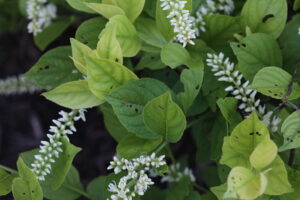Over the past 15 years the red-headed flea beetle, Systena frontalis has become an important pest in Indiana nurseries. Adult beetles feed on leaves of a wide variety of popular shrubs like hydrangea, azaleas and rhododendrons, bottlebrush, weigela, Virginia sweetspire, summersweet, roses, and hollies. Although the leaf feeding rarely harms plant health, plants with significant numbers of chewed leaves are often too unsightly to sell to customers. As such this insect is emerging as one of the most important insect pests in the nursery industry throughout the United States.
- Adult red headed flea beetles feed by scraping or chewing through leaf tissue of young tender leaves.
- Adult red headed flea beetles feeding on this hydrangea caused too much defoliation to allow it to be sold.
- Virginia sweetspire is one of many plants attacked by red headed flea beetles.
Red headed flea beetles thrive in the moist conditions of container plants in nurseries. Eggs overwinter in soil and hatch in spring. Creamy white larvae hatch from eggs and are easily found at the edge of moist root balls in container grown plants. Adults emerge from soil when inkberry holly is in bloom. A second generation of larvae present in mid-summer become the adults that lay the overwintering eggs in soil in late summer. We have seen all three stages in container grown plants in mid-summer. A third generation is likely in Indiana container grown nurseries.

Larvae(left) and pupae(right) can be found in pots of infested plants, but rarely damage the root system. Photos by Matt Bertone North Carolina State University.
Nursery grown plants can be difficult to protect. Although injury can be reduced by a regular foliar application of insecticides, the level of protection is not always complete. I conducted a trial in Indianapolis in 2021 to try to control this pest by spraying plants every two weeks. I started the trial when I saw the first beetles feeding on limelight hydrangeas on May 24 at 460 Growing Degree Days base 50 (GDD50). Every insecticide I used, protected plants for the first month (June 24 1090 GDD50). After this point adult beetles became plentiful as adults emerged from containers in the nursery. By July 5, (1375 GDD50) damage became unacceptable on most of the commercially available treatments. By July 28, none of the commercially available treatments provided protection.
Best Practices for Managing Red Headed Flea Beetles. Research conducted on the best approach protecting plants has been summarize in a recent article by Danny Lauderdale of North Carolina State University. Highlights of this article (available at this link) are as follows:
- Use Foliar Sprays to kill adults. A wide range of insecticides can be applied to provide acceptable control. These must be sprayed when adults are first seen. This can start around 500 GDD50, or earlier if nursery pots and beetles winter in protected structures. Sprays may need to be applied weekly if you continue to see significant numbers of live beetles on your plants during weekly inspections. Of the 15 compounds he lists that provide efficacy, Sarisa, Pradia, Acephate 97UP and Duragard ME are among the more effective based on his groups observatins and what I have seen in Indiana. Be sure to rotate classes of insecticides to avoid developing resistance and exceeding seasonal limits to the use of each pesticide. Although repeated applications are needed, many growers find it easier to apply than drenching or applying granules to pots.
- Use soil drenches or granular applications to kill larvae in pots. Applications of neonicotinoid insecticides when timed just before the beetle eggs hatch into larvae in the growing containers (212 GDD50) can provide excellent control. The most effective soil drenches included Acephate 97 UP, Arena 50 WDG (clothianidin), Coretect (imidacloprid), Discus NG(Imidacloprid+ bifenthrin), Flagship 25 WG (thiamethoxam), Tree and Shrub 2G(imidacloprid), Imidacloprid 2F, Marathon 1G, and Marathon II, Safari 20 SG, Tristar 8.5 SL, Azatin O, and Duraguard ME. While this can be helpful many growers find it quite time consuming to drag hose or apply granules to each pot.
- Incorporate imidacloprid granules into potting mix. Using Mallet 0.5 G as his source of imidacloprid in April, plants had < 10% damaged leaves through mid August. See this link on soil incorporation for details.
- Rotate crops. Do not put susceptible plants in the same area every year. Swap out tender leafed plants with some potted conifers to avoid buildup of pests in the same area.
- Don’t let pots have a birthday on your farm. Plants in the nursery for more than a year can build up populations of flea beetles in containers that you will have to contend with the next year.
Additional Resources:
Video: https://twitter.com/cliffsadof/status/1415385964286025729?s=21
Video caption: Watch the red headed flea beetle jump into flight! (Video by Layton Rosen)
Acknowledgments.
Thanks to Danny Lauderdale for providing an update on his research and Richard Marsh who let me conduct trials at Behob’s Nursery. After he helped me drag the hose so I could use his sprayer to hand drench a bay of nursery pots I now know exactly why growers find this process to be time consuming and costly.


